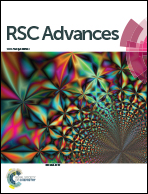Coordination polymer hydrogels through Ag(i)-mediated spontaneous self-assembly of unsubstituted nucleobases and their antimicrobial activity†
Abstract
Spontaneous formation of metallogels through the self-assembly of unsubstituted nucleobases with Ag(I) ions is reported. Whereas adenine, cytosine, thymine and uracil form metallogels under deprotonated conditions with nanofibrillar morphology, gelation of guanine with Ag(I) occurs only under acidic conditions through the self-organization of nanoscale metal–organic particles. In situ reduction of Ag salts occurs in Ag–pyrimidine gels to yield Ag nanoparticles decorated on the gel nanofibers. The Ag–nucleobase hydrogels showed excellent antimicrobial properties against both Gram positive as well as Gram negative bacteria.

- This article is part of the themed collection: Editors Collection for RSC Advances - India

 Please wait while we load your content...
Please wait while we load your content...